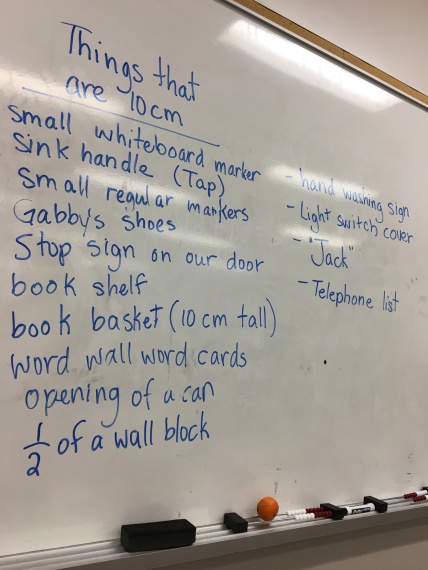This week we took a slight detour on to some measuring. We spent the week talking about making sure the measuring tool goes from end to end when measuring length. We talked about the difference between length and width. We talked about why we need to use standardized measurement tools. (Most of my class are in grade 3, and that is the year students move from non-standard to standard measurements.)
One of the activities we did comes from the Effective Guide to Instruction (Page 99 of this document). Last week I wrote about how I wanted my students to make more intentional decisions about which tools they choose for their math. The day before we measured the paper snakes, we had measured our shoes. As always, the two most popular tools were the connecting cubes and the “special stones”. Before starting with the snakes, we had a talk about why they like these, and which one is actually better for measuring. I was excited at the end when most of them were talking about using the connecting cubes because you can take them apart and put them back together in different shapes. One student told us they can be used to go around the perimeter of things. Several of them talked about how the special stones, the colour tiles and the pattern blocks slip and move around, but the connecting cubes stay put which makes them easier.
On to the activity:
Two children also tried to use rulers and measuring tape. Discussing their experience was a great way to wrap up the lesson because even though these are specifically measuring tools they weren’t the best tools for this job.
We had a really good conversation about which method was actually going to give us the real length of the snakes. Everyone agreed by the end that we have to measure every part of the snake’s length, and many of them wanted them put the cubes into connected towers. I was sorry that none of them thought to do groups of 5 to help make the counting more efficient. That’s something we clearly need to work more on. We recorded everything on a chart and that’s where we started on Friday. We talked about why everyone had different answers, and why it was important to have the same answers which we get when we agree on the units. I told them about the king’s foot and how this wasn’t even that standard, and that even though a lot of grown-ups still talk about inches for certain measurements, we are going to focus on the metric system and I think they’ll agree that it’s a lot more efficient. I had them wander around finding things that were the same size as a 1cm cube. Then we used the rulers and the measuring tapes to find things that are 10 cm.

I think it’s so important for them to have these many points of reference. It helps them to estimate measurements. They all now know that their fingernail is about 1cm and they will always have that fingernail to help them measure. We even talked about how for me it’s only my pinkie finger because I have grown over time.
Next week it’s on to addition and subtraction. But we’ll be coming back to measuring on a regular basis. This is actually the second week we’ve spent measuring this year, so now I feel confident that everyone has a pretty good idea of how to do it, and we can focus on practicing. We are also going to do a fair bit of our measuring during art and science, especially when we move on to capacity and weight.








You must be logged in to post a comment.